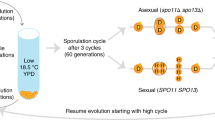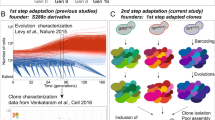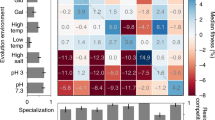Abstract
Ploidy varies considerably in nature. However, our understanding of the impact of ploidy on adaptation is incomplete. Many microbial evolution experiments characterize adaptation in haploid organisms, but few focus on diploid organisms. Here, we perform a 4,000-generation evolution experiment using diploid strains of the yeast Saccharomyces cerevisiae. We show that the rate of adaptation and spectrum of beneficial mutations are influenced by ploidy. Haldane’s sieve effectively alters access to recessive beneficial mutations in diploid populations, leading to a slower rate of adaptation and a spectrum of beneficial mutations that is shifted towards dominant mutations. Genomic position also has an important role, as the prevalence of homozygous mutations is largely dependent on their proximity to a recombination hotspot. Our results demonstrate key aspects of diploid adaptation that have previously been understudied and provide support for several proposed theories.
This is a preview of subscription content, access via your institution
Access options
Access Nature and 54 other Nature Portfolio journals
Get Nature+, our best-value online-access subscription
$29.99 / 30 days
cancel any time
Subscribe to this journal
Receive 12 digital issues and online access to articles
$119.00 per year
only $9.92 per issue
Buy this article
- Purchase on Springer Link
- Instant access to full article PDF
Prices may be subject to local taxes which are calculated during checkout





Similar content being viewed by others
References
Hummer, K. E., Nathewet, P. & Yanagi, T. Decaploidy in Fragaria iturupensis (Rosaceae). Am. J. Bot. 96, 713–716 (2009).
Goodenough, U. & Heitman, J. Origins of eukaryotic sexual reproduction. Cold Spring Harb. Perspect. Biol. 6, a016154 (2014).
Orr, H. A. & Otto, S. P. Does diploidy increase the rate of adaptation? Genetics 136, 1475–1480 (1994).
Haldane, J. B. S. A mathematical theory of natural and artificial selection, part V: selection and mutation. Proc. Camb. Philos. Soc. 23, 838–844 (1927).
de Godoy, L. M. et al. Comprehensive mass-spectrometry-based proteome quantification of haploid versus diploid yeast. Nature 455, 1251–1254 (2008).
Galitski, T., Saldanha, A. J., Styles, C. A., Lander, E. S. & Fink, G. R. Ploidy regulation of gene expression. Science 285, 251–254 (1999).
Paquin, C. & Adams, J. Frequency of fixation of adaptive mutations is higher in evolving diploid than haploid yeast populations. Nature 302, 495–500 (1983).
Anderson, J. B., Sirjusingh, C. & Ricker, N. Haploidy, diploidy and evolution of antifungal drug resistance in Saccharomyces cerevisiae. Genetics 168, 1915–1923 (2004).
Gerstein, A. C., Cleathero, L. A., Mandegar, M. A. & Otto, S. P. Haploids adapt faster than diploids across a range of environments. J. Evol. Biol. 24, 531–540 (2011).
Selmecki, A. M. et al. Polyploidy can drive rapid adaptation in yeast. Nature 519, 349–352 (2015).
Zeyl, C., Vanderford, T. & Carter, M. An evolutionary advantage of haploidy in large yeast populations. Science 299, 555–558 (2003).
Kryazhimskiy, S., Rice, D. P., Jerison, E. R. & Desai, M. M. Global epistasis makes adaptation predictable despite sequence-level stochasticity. Science 344, 1519–1522 (2014).
Kvitek, D. J. & Sherlock, G. Whole genome, whole population sequencing reveals that loss of signaling networks is the major adaptive strategy in a constant environment. PLoS Genet. 9, e1003972 (2013).
Lang, G. I. et al. Pervasive genetic hitchhiking and clonal interference in forty evolving yeast populations. Nature 500, 571–574 (2013).
Tenaillon, O. et al. The molecular diversity of adaptive convergence. Science 335, 457–461 (2012).
Scott, A. L., Richmond, P. A., Dowell, R. & Selmecki, A. M. The influence of polyploidy on the evolution of yeast grown in a sub-optimal carbon source. Mol. Biol. Evol. 34, 2690–2703 (2017).
Gerstein, A. C., Kuzmin, A. & Otto, S. P. Loss-of-heterozygosity facilitates passage through Haldane’s sieve for Saccharomyces cerevisiae undergoing adaptation. Nat. Commun. 5, 3819 (2014).
Sellis, D., Callahan, B. J., Petrov, D. A. & Messer, P. W. Heterozygote advantage as a natural consequence of adaptation in diploids. Proc. Natl Acad. Sci. USA 108, 20666–20671 (2011).
Sellis, D., Kvitek, D. J., Dunn, B., Sherlock, G. & Petrov, D. A. Heterozygote advantage is a common outcome of adaptation in Saccharomyces cerevisiae. Genetics 203, 1401–1413 (2016).
Deutschbauer, A. M. et al. Mechanisms of haploinsufficiency revealed by genome-wide profiling in yeast. Genetics 169, 1915–1925 (2005).
Wiser, M. J., Ribeck, N. & Lenski, R. E. Long-term dynamics of adaptation in asexual populations. Science 342, 1364–1367 (2013).
Wenger, J. W. et al. Hunger artists: yeast adapted to carbon limitation show trade-offs under carbon sufficiency. PLoS Genet. 7, e1002202 (2011).
Keil, R. L. & Roeder, G. S. cis-acting, recombination-stimulating activity in a fragment of the ribosomal DNA of S. cerevisiae. Cell 39, 377–386 (1984).
Magwene, P. M. et al. Outcrossing, mitotic recombination, and life-history trade-offs shape genome evolution in Saccharomyces cerevisiae. Proc. Natl Acad. Sci. USA 108, 1987–1992 (2011).
Mandegar, M. A. & Otto, S. P. Mitotic recombination counteracts the benefits of genetic segregation. Proc. R. Soc. B 274, 1301–1307 (2007).
Koschwanez, J. H., Foster, K. R. & Murray, A. W. Sucrose utilization in budding yeast as a model for the origin of undifferentiated multicellularity. PLoS Biol. 9, e1001122 (2011).
Lang, G. I., Botstein, D. & Desai, M. M. Genetic variation and the fate of beneficial mutations in asexual populations. Genetics 188, 647–661 (2011).
Oud, B. et al. Genome duplication and mutations in ACE2 cause multicellular, fast-sedimenting phenotypes in evolved Saccharomyces cerevisiae. Proc. Natl Acad. Sci. USA 110, E4223–E4231 (2013).
Ratcliff, W. C., Denison, R. F., Borrello, M. & Travisano, M. Experimental evolution of multicellularity. Proc. Natl Acad. Sci. USA 109, 1595–1600 (2012).
Kraus, E., Leung, W. Y. & Haber, J. E. Break-induced replication: a review and an example in budding yeast. Proc. Natl Acad. Sci. USA 98, 8255–8262 (2001).
Buskirk, S. W., Peace, R. E. & Lang, G. I. Hitchhiking and epistasis give rise to cohort dynamics in adapting populations. Proc. Natl Acad. Sci. USA 114, 8330–8335 (2017).
Mans, R. et al. CRISPR/Cas9: a molecular Swiss army knife for simultaneous introduction of multiple genetic modifications in Saccharomyces cerevisiae. FEMS Yeast Res. 15, fov004 (2015).
Baym, M. et al. Inexpensive multiplexed library preparation for megabase-sized genomes. PloS ONE 10, e0128036 (2015).
Matheson, K., Parsons, L. & Gammie, A. Whole-genome sequence and variant analysis of W303, a widely-used strain of Saccharomyces cerevisiae. G3 (Bethesda) 7, 2219–2226 (2017).
Acknowledgements
We thank M. Remillard (Princeton University) for providing strains; A. Nguyen and M. Desai (Harvard University) for providing the plasmid with mating-type-specific selectable markers; A. Selmecki, K. Fisher and R. Vignogna for their comments on the manuscript. This work was supported by the Charles E. Kaufman Foundation of The Pittsburgh Foundation.
Author information
Authors and Affiliations
Contributions
G.I.L. designed the project. D.A.M. performed the experiments. S.W.B. and D.A.M. performed the sequencing analysis pipeline. D.A.M. and G.I.L. analysed the data and wrote the manuscript.
Corresponding author
Ethics declarations
Competing interests
The authors declare no competing interests.
Additional information
Publisher’s note: Springer Nature remains neutral with regard to jurisdictional claims in published maps and institutional affiliations.
Supplementary information
Supplementary Information
Supplementary Figs. 1–8, Supplementary Table 1
Supplementary Table 2
Mutations detected in two clones each from 24 diploid populations
Rights and permissions
About this article
Cite this article
Marad, D.A., Buskirk, S.W. & Lang, G.I. Altered access to beneficial mutations slows adaptation and biases fixed mutations in diploids. Nat Ecol Evol 2, 882–889 (2018). https://doi.org/10.1038/s41559-018-0503-9
Received:
Accepted:
Published:
Issue Date:
DOI: https://doi.org/10.1038/s41559-018-0503-9
This article is cited by
-
Long-Term Adaptation to Galactose as a Sole Carbon Source Selects for Mutations Outside the Canonical GAL Pathway
Journal of Molecular Evolution (2023)
-
Identifying Targets of Selection in Laboratory Evolution Experiments
Journal of Molecular Evolution (2023)
-
Natural variation in Drosophila shows weak pleiotropic effects
Genome Biology (2022)
-
Spontaneous mutation rate estimates for the principal malaria vectors Anopheles coluzzii and Anopheles stephensi
Scientific Reports (2022)
-
Evolutionary dynamics and structural consequences of de novo beneficial mutations and mutant lineages arising in a constant environment
BMC Biology (2021)



